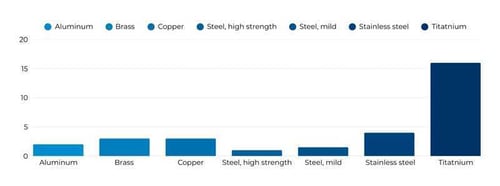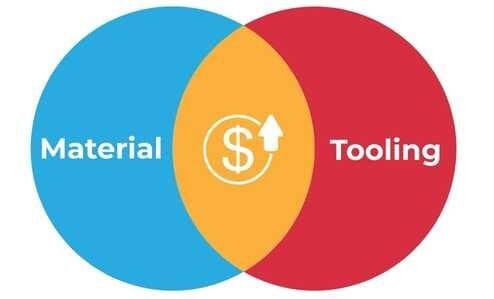How do you quantify material costs? That’s a pretty important question in the hardware development space, and by no means an easy one to answer.
Defining material cost isn’t as simple as creating a list of potential materials you can use for your part based on mechanical, thermal, and other relevant properties, then choosing the cheapest one.
I’ll give you a few scenarios:
- In one instance, you may be using a material that’s costly, but due to its machinability, you can use inexpensive, or generic, cutting tools
- Or, you can have a cheap material, but due to its properties, it contributes to increased tooling costs either by incurring tool wear or by requiring expensive tools (tool material, coating, tooling geometry, etc.).
Think of it as a Venn diagram. You can’t make assumptions about material cost solely by considering dollars per inch of material; you also need to consider what the material will interact with – specifically, cutting tools.

Expensive Materials to CNC Machine
Materials are considered “expensive” based either on the cost of the raw material or the incurred expenses it takes to machine those materials – in this case, tooling costs.
By no means is this list exhaustive, but let’s take a look at some of the more expensive metals and plastics that are commonly machined.
Metals
With the exception of titanium, as you’ll see below, the most commonly machined metals have a relatively low raw material cost. This is great for minimizing overall material costs, considering that tooling factors often add significant cost.

Titanium
Titanium is expensive due to the high raw material and fabrication costs associated with producing finished material. This makes it cost-prohibitive for most high-volume applications.
Stainless Steel
Stainless steel is not an exotic metal, but cost has nothing to do with raw material and everything to do with mechanical properties. Stainless steel is tough, prone to work-hardening and burrs, hard on tools, and requires longer cycle times due to decreased speeds and feeds.
Copper (and Brass)
Copper isn’t the most expensive material, but due to its mechanical properties (abrasiveness, gumminess, chip build-up) and thermal conductivity, it requires more tool changes to machine and causes more tool wear. It’s also difficult to finish on the machine and requires either additional passes or deburring steps, which drive up cost.
Plastics
In the case of plastics, which tend to be more machinable than metals, material-related costs typically boil down to either the fabrication process or the raw material that is synthesized into the final product.
PEEK
PEEK is a high-performing engineering plastic that’s easy to machine and boasts great mechanical and chemical properties. However, due to the manufacturing process and the monomers used to synthesize it, it has a high raw material cost. Both of these factors contribute to a higher cost per part as a result of the chosen material.
PCTFE
PCTFE is a fluoropolymer that’s known for strength, stiffness, and dimensional stability, but it’s very expensive to make. PCTFE is comprised of costly raw materials (particularly chlorotrifluoroethylene), requires a complex manufacturing process, and sees a higher per-unit cost due to its limited production.
Acetal
Acetal, commonly known by the brand name Delrin, is a high-strength, low-friction engineering plastic characterized by exceptional wear properties and chemical resistance. Although it is relatively easy to machine, Acetal is more expensive to produce than more common plastics. The raw materials required are costly, and the manufacturing process demands sophisticated equipment, all of which contribute to its higher cost.
PPS
PPS is a chemical and corrosion-resistant plastic with excellent mechanical and thermal properties. Similar to the other plastics you’ve already read about, the raw materials and complex manufacturing process are both costly and reflect in the bottom line.

Expensive Cutting Tools
Concerning how material impacts your cost per unit, you haven’t escaped an expensive project just because your raw material costs are low. You also need to consider your cutting tools, as they can add a significant cost to your overall project.
Diamond Tools
These are among the most expensive due to their exceptional hardness and wear resistance. They are used for ultra-precision machining and cutting hard materials like ceramics and composites.
Carbide Tools
Tungsten carbide tools are highly durable and can withstand high temperatures, making them ideal for high-speed machining. They are more expensive than standard steel tools and are typically used on hard metals like stainless steel, titanium, hardened steel, and cast iron. They’re also effective on non-ferrous materials like aluminum and copper.
Ceramic Tools
Made from advanced ceramic materials, these tools are used for high-speed machining of hard metals. Their high cost is due to the complex manufacturing process and material properties.
PCBN Tools
PCBN (Polycrystalline Cubic Boron Nitride) tools are second only to diamond in terms of hardness, making them extremely hard and wear-resistant. They’re used for machining hard steels and superalloys, and, for this reason, are very expensive.

So, don’t forget that this is a Venn diagram – take both the price of the material and the cutting tools that will be required into account to determine a project’s costs as it relates to material.



